GIGABYTE Server GA-7PESH3 Motherboard Review
by Ian Cutress on September 4, 2014 2:00 PM EST- Posted in
- Motherboards
- Intel
- Gigabyte
- Xeon
- Workstation
- Enterprise
- C602
Many thanks to...
We must thank the following companies for kindly providing hardware for our test bed:
- Thank you to OCZ for providing us with PSUs and SSDs.
- Thank you to G.Skill for providing us with memory.
- Thank you to Corsair for providing us with an AX1200i PSU and a Corsair H80i CLC.
- Thank you to MSI for providing us with the NVIDIA GTX 770 Lightning GPUs.
- Thank you to Rosewill for providing us with PSUs and RK-9100 keyboards.
- Thank you to ASRock for providing us with some IO testing kit.
- Thank you to Cooler Master for providing us with Nepton 140XL CLCs.
- Thank you to GIGABYTE for providing us with the CPUs.
Test Setup
| Processor |
2x Intel E5-2697 v2 2x Intel E5-2687W v2 |
2x 12C/24T 2x 8C/16T |
2.7 GHz / 3.5 GHz 3.4 GHz / 4.0 GHz |
|
| Motherboard | GIGABYTE GA-7PESH3 | |||
| Cooling |
Corsair H80i Cooler Master Nepton 140XL |
|||
| Power Supply |
OCZ 1250W Gold ZX Series Corsair AX1200i Platinum PSU |
1250W 1200W |
80 PLUS Gold 80 PLUS Platinum |
|
| Memory | Kingston 8x4GB ECC | DDR3-600 | 11-11-11 1.5V | |
| Memory Settings | XMP | |||
| Video Cards | MSI GTX 770 Lightning 2GB (1150/1202 Boost) | |||
| Video Drivers | NVIDIA Drivers 337.88 | |||
| Hard Drive | OCZ Vertex 3 | |||
| Optical Drive | LG GH22NS50 | |||
| Case | Open Test Bed | |||
| Operating System | Windows 7 64-bit SP1 | |||
| USB 2/3 Testing | OCZ Vertex 3 240GB with SATA->USB Adaptor | |||
System Benchmarks
Power Consumption
Power consumption was tested on the system while in a single MSI GTX 770 Lightning GPU configuration with a wall meter connected to the OCZ 1250W power supply. This power supply is Gold rated, and as I am in the UK on a 230-240 V supply, leads to ~75% efficiency > 50W, and 90%+ efficiency at 250W, suitable for both idle and multi-GPU loading. This method of power reading allows us to compare the power management of the UEFI and the board to supply components with power under load, and includes typical PSU losses due to efficiency. These are the real world values that consumers may expect from a typical system (minus the monitor) using this motherboard.
While this method for power measurement may not be ideal, and you feel these numbers are not representative due to the high wattage power supply being used (we use the same PSU to remain consistent over a series of reviews, and the fact that some boards on our test bed get tested with three or four high powered GPUs), the important point to take away is the relationship between the numbers. These boards are all under the same conditions, and thus the differences between them should be easy to spot.
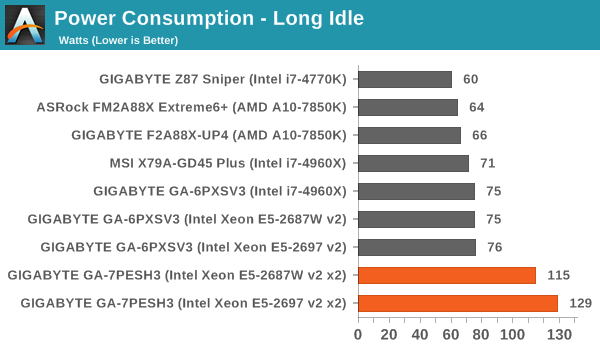
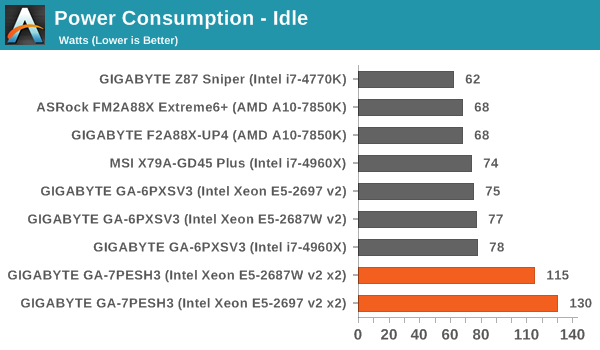
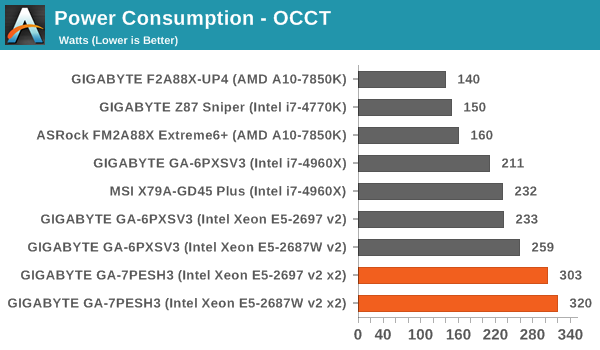
When we compare the system loads between one processor and two processors, it seems odd that the second processor does not seem to add much to the process at load but a good chunk while idle. Note we are comparing the single socket server motherboard to the GA-7PESH3, but it is still much of a jump. Idle power consumption on these boards is quite high, however these machines are built more for a 24/7 workload.
Windows 7 POST Time
Different motherboards have different POST sequences before an operating system is initialized. A lot of this is dependent on the board itself, and POST boot time is determined by the controllers on board (and the sequence of how those extras are organized). As part of our testing, we look at the POST Boot Time using a stopwatch. This is the time from pressing the ON button on the computer to when Windows 7 starts loading. (We discount Windows loading as it is highly variable given Windows specific features.)
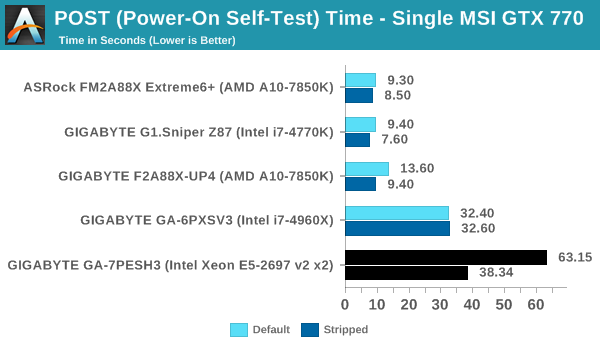
Like any other server-based motherboard we have ever tested, POST times are long. Half of this is going from pressing the ON button and the management software to do its thing before the CMOS takes over. Even then, the dual server-grade Intel NICs have their own integration sequence, along with the RAID subsystem. It all adds up, and that is why we can cut it down to under 40 seconds by disabling controllers if they are not in use.
Rightmark Audio Analyzer 6.2.5
Rightmark:AA indicates how well the sound system is built and isolated from electrical interference (either internally or externally). For this test we connect the Line Out to the Line In using a short six inch 3.5mm to 3.5mm high-quality jack, turn the OS speaker volume to 100%, and run the Rightmark default test suite at 192 kHz, 24-bit. The OS is tuned to 192 kHz/24-bit input and output, and the Line-In volume is adjusted until we have the best RMAA value in the mini-pretest. We look specifically at the Dynamic Range of the audio codec used on board, as well as the Total Harmonic Distortion + Noise.
Dynamic Range of the GIGABYTE GA-7PESH3
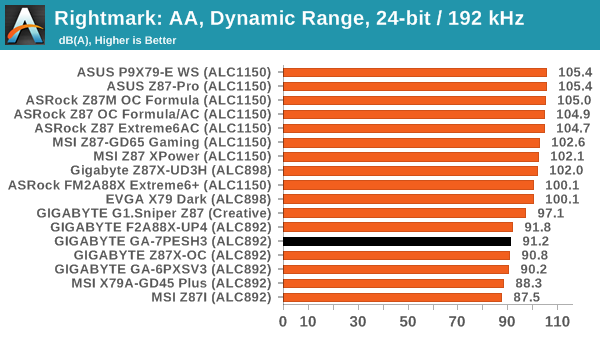
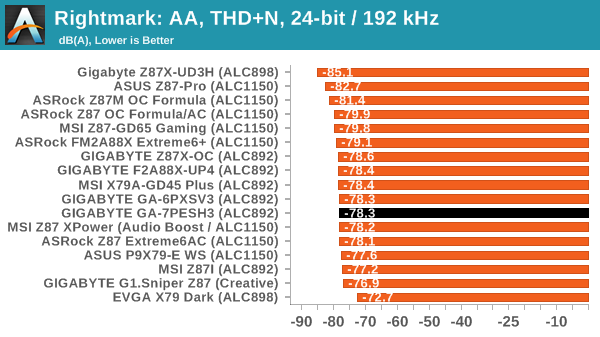
As the 7PESH3 is different to our previous 2P server motherboards in actually having motherboard audio, it should be applauded. The downside is that the ALC892 is the midrange 7.1 Realtek NIC, and is usually outperformed by the ALC898 and ALC1150. For a motherboard that costs $640, I am in two minds as to demand the higher codec. Audio might not be a target for a system like this, however the price demands something better than average.
USB Backup
For this benchmark, we transfer a set size of files from the SSD to the USB drive using DiskBench, which monitors the time taken to transfer. The files transferred are a 1.52 GB set of 2867 files across 320 folders – 95% of these files are small typical website files, and the rest (90% of the size) are small 30 second HD videos. In an update to pre-Z87 testing, we also run MaxCPU to load up one of the threads during the test which improves general performance up to 15% by causing all the internal pathways to run at full speed.
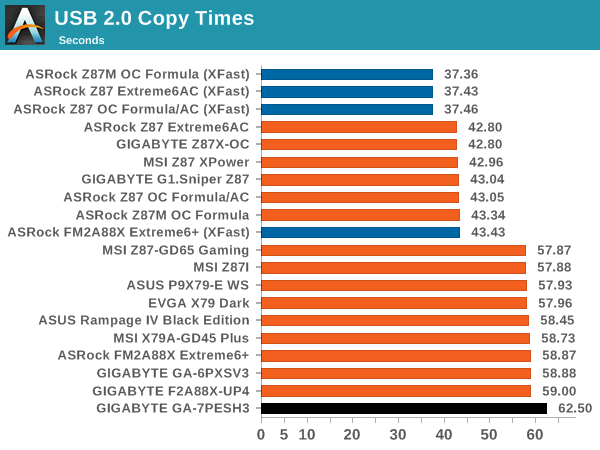
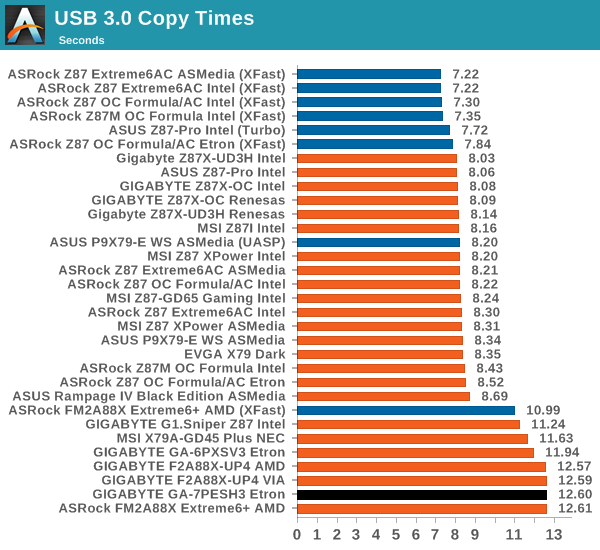
The consumer oriented business units at the major motherboard manufacturers have managed to implement a form of USB 2.0 (either in hardware or software) on their products to achieve around 43 seconds in our test. Those that have not implemented this difference hit around the 60 second mark, like the 7PESH3 does. The USB 3.0 also comes out slower than a consumer model due to the use of controllers.
DPC Latency
Deferred Procedure Call latency is a way in which Windows handles interrupt servicing. In order to wait for a processor to acknowledge the request, the system will queue all interrupt requests by priority. Critical interrupts will be handled as soon as possible, whereas lesser priority requests such as audio will be further down the line. If the audio device requires data, it will have to wait until the request is processed before the buffer is filled.
If the device drivers of higher priority components in a system are poorly implemented, this can cause delays in request scheduling and process time. This can lead to an empty audio buffer and characteristic audible pauses, pops and clicks. The DPC latency checker measures how much time is taken processing DPCs from driver invocation. The lower the value will result in better audio transfer at smaller buffer sizes. Results are measured in microseconds.
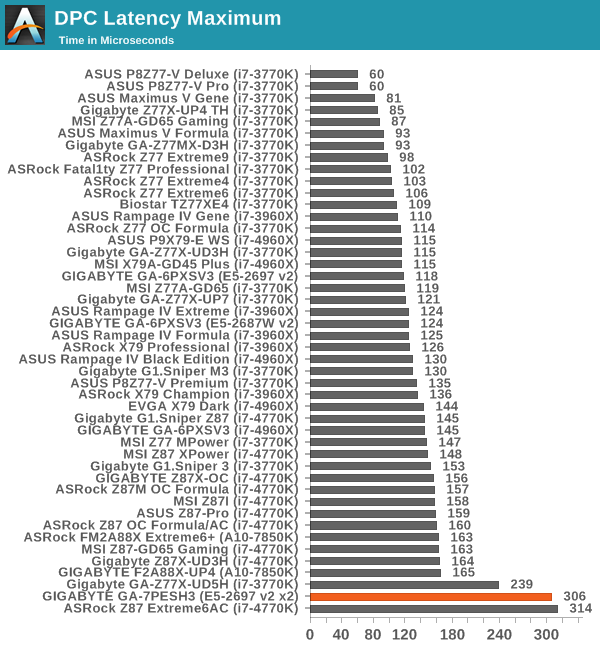
The DPC Latency for the 7PESH3 was a little odd:
The system seems to oscillate between ~100 microseconds and ~300 microseconds. Normally on most consumer motherboards this would happen due to the presence of an abnormal WiFi software stack, or an unoptimized BIOS. Server motherboards historically have done rather poor in this test, perhaps indicating that the server management tools constantly polling temperatures and fan speeds might be the contributing factor.



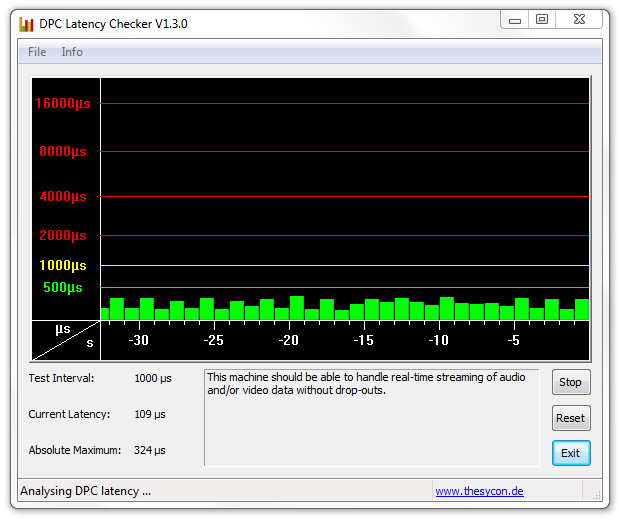








35 Comments
View All Comments
tuxRoller - Thursday, September 4, 2014 - link
So, you've got a workstation class board but are running Windows 8...Is it so difficult to throw centos on there for the benefit of those working at Pixar?
MrSpadge - Friday, September 5, 2014 - link
Those working at Pixar likely won't need an Ivy-EP review. Apart from that.. I'm sure Ian is glad not to have to deal with CentOS :ptuxRoller - Friday, September 5, 2014 - link
Centos is easy to setup, and the new release is quite nice.My point with Pixar was that there are many serious creators who use Linux workstations, and not just for simulations. Unless you work in the area it's possible you may not know the prevalence of Linux among workstations, especially relative to windows 8, in my experience.
That aside, seeing the comparative performance numbers of the two OS's is useful to get an idea of what the hardware itself can do.
mpbrede - Friday, September 5, 2014 - link
I really hope that this crappy grammar is just an indication of haste and not of lower editorial standards now that Anand has left the room."As a result, gaming often sees a hit in performance, as well as basic tasks." -> ...result, gaming, as well as basic tasks, sees a hit...
"Interestingly GIGABYTE does not supply any extra power connectors for these PCIe slots, indicating that not each port might not be able to provide 75W when all are populated (e.g. seven graphics cards)." -> read it slowly, how many "nots" should there be in a single sentence?
aryonoco - Friday, September 5, 2014 - link
A server/workstation motherboard requires its own benchmarks.For anyone who is in the target market of this product, this review is absolutely worthless. Gaming benchmarks? Really?!
colonelclaw - Friday, September 5, 2014 - link
Thanks for the review. In the future please consider including the following benchmarks:3DSMax + Vray, Maya + VRay/Arnold/Renderman, Adobe Media Encoder, Adobe After Effects, Adobe Premiere Pro. Some VRay RT and Octane multi-GPU benchmarks would be a nice addition, too.
The one thing I find slightly strange about this motherboard is the low number of memory slots. All our DP motherboards have twice as many per processor (and many are full). I wonder why Gigabyte decided on just eight?
eanazag - Friday, September 5, 2014 - link
I think the point of making the board where the CPUs line up was to allow better airflow to the add-on cards (GPUs). Lining up the CPUs didn't allow for the normal # of mem. slots.In actuality I would think most buyers of this board would just go with one CPU. It allows for the video compute cards to have more juice from the ATX 24 pin. I have bought 2P boards for one proc because of the peripheral items like slots, networking, RAID, and built-in network management. When you look at non-server boards and add the pricing of add-on management it starts to make you consider the server/workstation board.
The Von Matrices - Friday, September 5, 2014 - link
The reason for this is because Gigabyte chose to use square ILM sockets.For those who do not know, LGA2011 has two sockets - square ILM and narrow ILM. Most consumer motherboards use the square ILM sockets; you only see the narrow ILM sockets in servers. The narrow ILM socket is obviously narrower, which allows more memory slots on the same size motherboard. The disadvantage of the narrow ILM socket is that the memory slots are so close to the processor that large and quiet tower heatsinks can't be used since they cover the closest memory slots.
Basically, when designing a dual LGA2011 SSI CEB motherboard, you have to choose two of the three following features:
16 DIMM slots
7 PCIe slots
Square ILM sockets
If you use 16 DIMMs and 7 PCIe slots, you have to use narrow ILM sockets, which eliminates the use of tower heatsinks.
If you use 7 PCIe slots and square ILM sockets (like Gigabyte did) you now can use tower heatsinks. However, then there is only enough space on the motherboard for 8 or 12 DIMM slots.
If you use 16 DIMMs and square ILM sockets, there's only enough space on the motherboard for 6 PCIe slots.
joannecdinkins - Friday, September 5, 2014 - link
just as Larry answered I didnt even know that people able to get paid $6104 in a few weeks on the internet .go to this site>>>>> paygazette.ℭOM
KAlmquist - Friday, September 5, 2014 - link
One thing that's not addressed in this review is whether it makes sense to run Windows 7 on a multi-socket system. The benchmarks showing dual E5-2687W processors running significantly slower than a single E5-2687W suggest that Windows 7 is making bad scheduling decisions. Would Windows Server or Linux do better?Let me explain my point about scheduling decisions in a bit more detail. If you run a piece of software on a system with a single processor, the operating system has to make decisions about when to run each thread, and which core to run it on. Now switch to a system which is similar to the first system except that it has two processors. If the operating system simply ignores the second processor, and makes the same scheduling decisions as it made on the first system, then the performance of the two systems should be quite close. I'm not suggesting that this approach to scheduling on a dual processors system makes sense, but it is a possible approach. So if the approach to scheduling used by Windows 7 results in even worse performance, we know that Windows 7 could do better. In fairness to Microsoft, Windows 7 is not marketed as a server OS, so maybe it shouldn't be expected to perform well on server hardware.